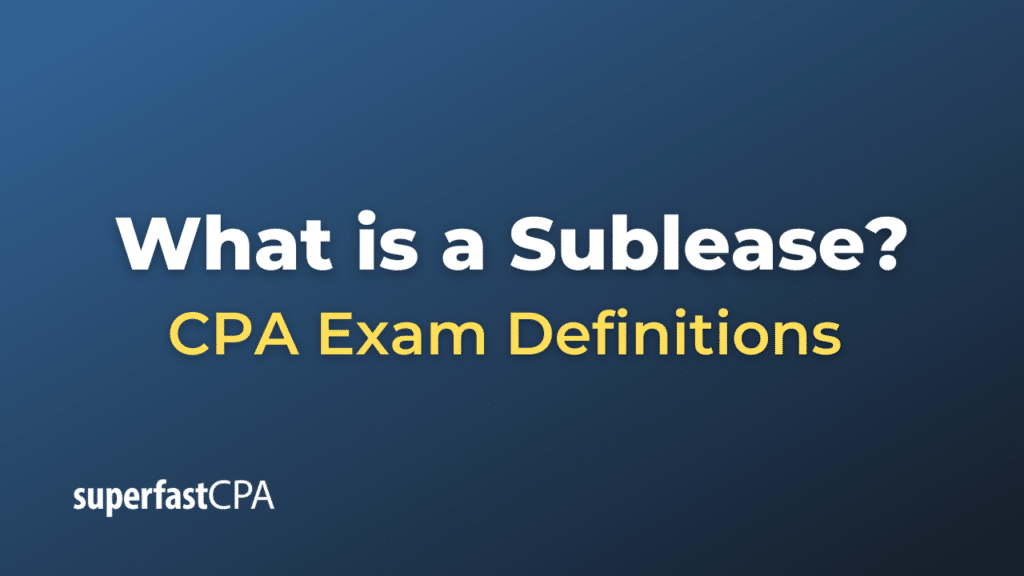Sublease
A sublease, also known as a sublet, is an arrangement in which an existing tenant (known as the sublessor or sublettor) rents out their leased property (or a portion of it) to another party (known as the sublessee or subtenant) for a specific duration. This arrangement is typically subject to the original lease’s terms and conditions between the primary tenant and the property owner (known as the landlord or lessor).
In a sublease:
- The original tenant retains certain responsibilities under the original lease agreement. This means if the sublessee fails to pay rent or damages the property, the original tenant may be held responsible by the landlord.
- The sublessee pays rent to the sublessor, not directly to the property’s landlord, unless a different arrangement is agreed upon.
- The duration of the sublease cannot exceed the remaining term of the original lease, unless the landlord agrees to extend it.
Before subletting, the original tenant should:
- Check the Master Lease: Many rental agreements contain clauses related to subletting. Some leases prohibit it entirely, while others might allow it with the landlord’s prior consent. Before proceeding with a sublease, it’s crucial to review the original lease agreement and obtain any necessary permissions.
- Draw Up a Sublease Agreement: This agreement should outline the terms of the sublease, including rent amount, duration, responsibilities, and any other relevant conditions. It’s essential to have a written agreement to protect the interests of both the original tenant and the sublessee.
- Stay Informed and Involved: Even after subletting the property, the original tenant remains bound by the terms of the original lease. Hence, they should stay informed about the property’s condition and ensure that the sublessee adheres to the agreed-upon terms.
Subleasing can be beneficial in various situations, such as when the original tenant needs to move for a temporary job assignment or extended travel but doesn’t want to terminate the primary lease. However, it’s essential to approach the process with caution and due diligence to ensure all parties’ rights and responsibilities are clear and protected.
Example of a Sublease
Let’s delve into a practical example to illustrate a sublease scenario.
Scenario: “The Study Abroad Sublease”
Background: Emily is a university student living in a two-bedroom apartment in New York City. She has signed a one-year lease agreement with her landlord, Mrs. Anderson. Four months into her lease, Emily receives an opportunity to study abroad in Paris for six months. She doesn’t want to break her lease in New York, as she plans to return after her study program.
The Sublease:
- Reviewing the Master Lease: Emily checks her lease agreement with Mrs. Anderson and finds a clause stating that subleasing is allowed with the landlord’s written consent.
- Finding a Sublessee: Emily advertises the apartment on a few student housing websites. After meeting several interested parties, she decides on Jake, a graduate student looking for short-term housing for his upcoming semester.
- Seeking Permission: Emily formally writes to Mrs. Anderson, explaining her situation and introducing Jake. She requests permission to sublease her apartment for six months. Mrs. Anderson agrees, provided that Emily remains responsible for any unpaid rents or damages.
- Drafting the Sublease Agreement: Emily and Jake create a sublease agreement. The document states the rent amount, duration (six months), and other conditions like Jake not being allowed to sublet further or make significant changes to the apartment. They both sign this agreement.
- Rent Payment: Jake agrees to pay Emily directly each month. Emily continues to make her regular rent payments to Mrs. Anderson, ensuring there’s no disruption.
- End of Sublease: After six months, Jake moves out, leaving the apartment in good condition. Emily returns from Paris and resumes her life in her NYC apartment, with two more months left on her original lease with Mrs. Anderson.
This example showcases a relatively smooth subleasing process. Emily managed to avoid breaking her lease and paying potential penalties, while Jake found a short-term housing solution that suited his needs. Mrs. Anderson, the landlord, continued to receive her monthly rent without any issues. Proper communication and a clear sublease agreement were key to the success of this arrangement.













